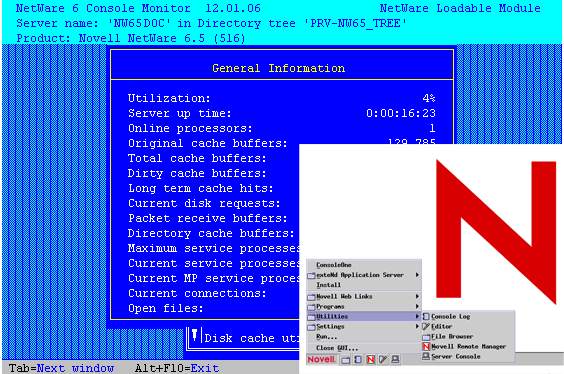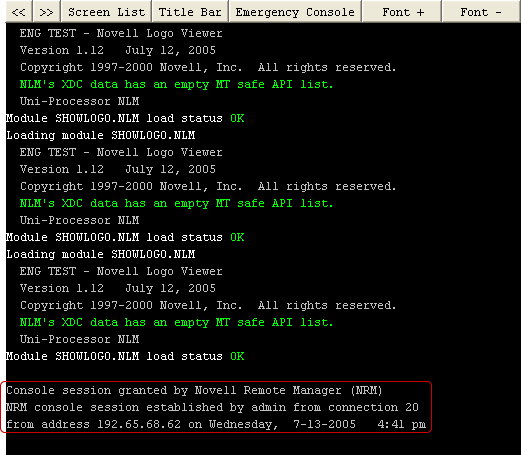7.3 Accessing and Running the Server Console Screens
You can access and use any of the server console screens from the page, including the server GUI.
Figure 7-3 Example Monitor Utility General Screen and the Server GUI Screen

For example, if you wanted to install a support pack update from a remote location, you could access the NWCONFIG utility using the link and then run it as though you were at the server console.
To access the Console Screens page, click the link in the navigation frame.
From these screens, you can perform the following tasks:
7.3.1 Running the Server Console Screens from the Dynamic Java Applet Pages
The Dynamic console screens let you run any of the console screens through the browser as though you were at the server console keyboard.
To do so, click any of the links listed under heading on the Console Screens page. Clicking these links runs a Java* applet that opens a secondary browser window that is running the screen listed.
In order to be confident about who is accessing the console, the following information is logged on the Logger screen when the console screens are accessed using this method:
-
Session is granted
-
Username
-
IP address of the node making the connection
-
Time that the connection is made
Figure 7-4 Example Console Session Granted Message

The following table explains what you can do from this secondary browser window.
Table 7-2 Tasks and Procedures Available from the Current Screens > Dynamic Link
7.3.2 Viewing and Running the Console Screen from HTML Pages
If for some reason you are unable to access the dynamic console screens, you can access an HTML-based screen under the heading on the Current Screen page. The screens listed are only screens that are currently running on the server console. These screens let you view the console screen and perform a limited number of tasks. The experience is not as easy as with a dynamic screen, but it does give you access to the screen and the ability in some cases to perform tasks.
When you click the link associated with each of these screens, you can view the screen and control the refresh rate only with the drop-down list at the top of the window. The HTML page for the System Console screen also allows you to enter console commands to be executed at the server console.
You can control the refresh rate of the different server pages. Refresh on the System Console page is suspended when you click .
7.3.3 Viewing Console Activity
The Logger screen lets you view most of the console activity information that was formerly displayed on the System Console screen. This screen is scrollable and can be saved to a file.
To access a list of commands for scrolling and saving to a file, press F1 while viewing the Logger screen, or click the link on the Console Screens page.